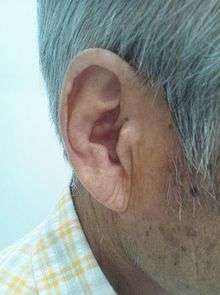Frank's sign


Frank's sign or Frank sign is a diagonal ear lobe crease (ELC) extending diagonally from the tragus across the lobule to the rear edge of the auricle.[1] The sign is named after Dr. Sanders T. Frank.[2]
It has been hypothesised that Frank's sign is indicative of cardiovascular disease[3] and/or diabetes.[4] Some studies have described Frank's sign as a marker of cardiovascular disease but not linked to the severity of the condition.[5] In contrast, other studies have rebutted any association between Frank's sign and coronary artery disease in diabetics.[6] There have also been reported cases of Frank's sign assisting in the diagnosis of cerebral infarctions. A link between Frank's sign and premature aging and the loss of dermal and vascular fibers has also been hypothesized.[7]
However, researchers do agree that these creases have no predictive value in Native American Indian and Asian patients.
Some studies have focused upon bilateral ELC.[8]
Severity
- Grade 3 - A deep crease across the whole of the earlobe
- Grade 2a - Creased more than halfway across the earlobe
- Grade 2b - A superficial crease across the earlobe
- Grade 1 - A small amount of wrinkling on the earlobe
Notable individuals with Frank's sign
References
- ↑ Frank ST (August 1973). "Aural sign of coronary-artery disease". N. Engl. J. Med. 289 (6): 327–8. doi:10.1056/NEJM197308092890622. PMID 4718047.
- ↑ Frank ST (August 1973). "Aural sign of coronary-artery disease". N. Engl. J. Med. 289 (6): 327–8. doi:10.1056/NEJM197308092890622. PMID 4718047.
- ↑ Miot, H.A., Molina de Medeiros, M. etal (2006). Association between coronary artery disease and the diagonal earlobe an preauricular creases in men. Anais Brasileiros de Dermatologia. vol.81 no.1
- ↑ Mustafa Ahmed, M.D. (13 August 2014). "Earlobe Crease And Heart Disease – Fact Or Myth?". Abel Healthcare. Retrieved 8 February 2015.
- ↑ Lesbre JP, Castier B, Tribouilloy C, Labeille B, Isorni C (January 1987). "[Frank's sign and coronary disease]". Ann Cardiol Angeiol (Paris) (in French). 36 (1): 37–41. PMID 3827155.
- ↑ Davis TM, Balme M, Jackson D, Stuccio G, Bruce DG (October 2000). "The diagonal ear lobe crease (Frank's sign) is not associated with coronary artery disease or retinopathy in type 2 diabetes: the Fremantle Diabetes Study". Aust N Z J Med. 30 (5): 573–7. doi:10.1111/j.1445-5994.2000.tb00858.x. PMID 11108067.
- ↑ George Griffing, M.D. (March 2014). "Frank's Sign". The New England Journal of Medicine. 370 (15). doi:10.1056/NEJMicm1213868.
- ↑ Evrengül H, Dursunoğlu D, Kaftan A, et al. (2004). "Bilateral diagonal earlobe crease and coronary artery disease: a significant association". Dermatology (Basel). 209 (4): 271–5. doi:10.1159/000080847. PMID 15539887.